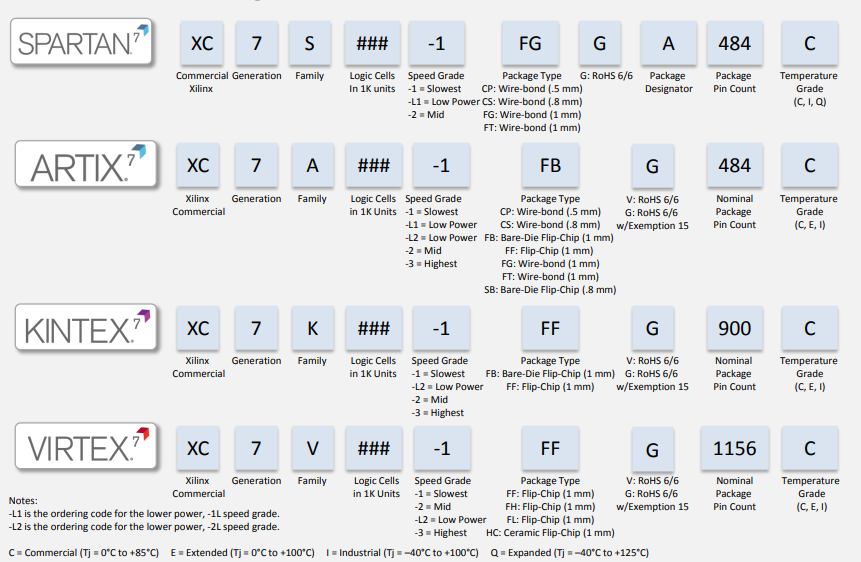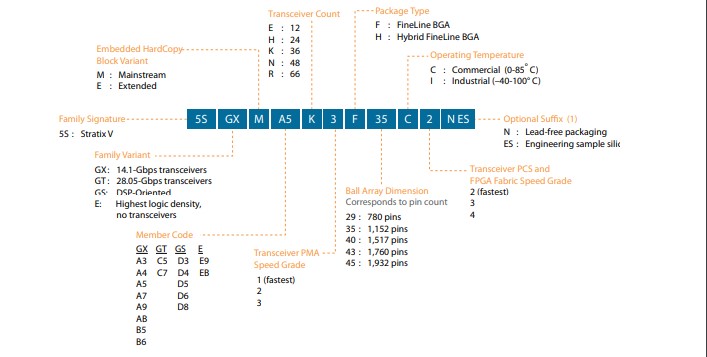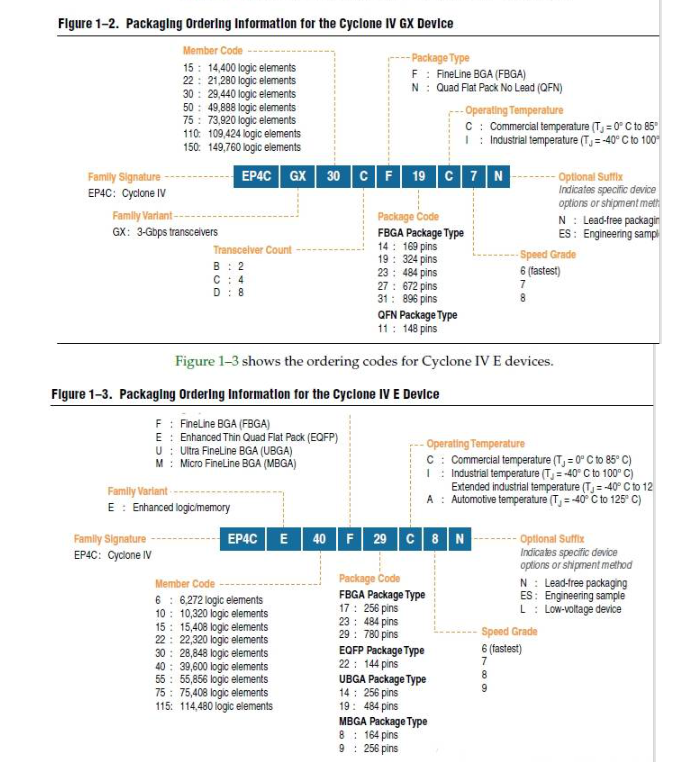Time: 2023-12-21 11:38:57View:
An FPGA stands for Field-Programmable Gate Array. A Field-Programmable Gate Array (FPGA) is an advancement in programmable devices such as PAL, GAL, and CPLD. It is a semi-specialized circuit that addresses the limitations of both specialized circuits and traditional programmable gate arrays. Unlike programming a standard microcontroller, an FPGA allows you to "implement" digital circuits using a hardware description language (HDL). VHDL and Verilog are two commonly used HDLs.
For more information about FPGA, you can read read this blog that I written before: What is FPGA?
In the following part, we will discuss the common series of FPGA and their features as well as their naming rules.
The first series that I want to talk about is manufactured by Xilinx, a well-know company. Xilinx offers a diverse range of FPGA series to cater to various application requirements. Some of the notable series from Xilinx include:
Virtex Series: The Virtex series is Xilinx's flagship FPGA series known for its high-performance capabilities. It offers industry-leading features such as high logic capacity, high-speed transceivers, advanced DSP blocks, and on-chip memory resources. The Virtex series is ideal for applications that require massive parallel processing, high-speed data communication, and real-time analytics. Common series like Virtex-6 FPGA.
Kintex Series: The Kintex series of FPGAs strikes a balance between performance and power efficiency. These FPGAs provide a cost-effective solution with a wide range of features including high logic density, moderate-speed transceivers, and efficient power management capabilities. The Kintex series is suitable for applications such as wireless communication, video processing, and embedded systems.
Artix Series: The Artix series offers cost-optimized FPGAs while still delivering substantial performance capabilities. These FPGAs provide a balance between cost, power efficiency, and performance, making them suitable for applications that require moderate logic density and low-to-moderate-speed transceivers. The Artix series is often used in industrial automation, automotive, and consumer electronics applications. Common series like Artix-7 FPGA.
Spartan Series: The Spartan series is designed for low-cost and low-power applications. These FPGAs offer a balance between cost-effectiveness and functionality, providing basic to moderate logic density and moderate-speed transceivers. The Spartan series is commonly used in applications such as IoT devices, automotive electronics, and industrial control systems.
Versal Series: The Versal series represents Xilinx's Adaptive Compute Acceleration Platform (ACAP), which combines FPGA fabric with advanced processing elements. Versal ACAPs offer a blend of FPGA flexibility and AI acceleration capabilities, targeting applications in artificial intelligence, machine learning, and data center acceleration.
RFSoC Series: The RFSoC (Radio Frequency System-on-Chip) series integrates RF data converters, high-speed transceivers, and FPGA fabric into a single device. These FPGAs are specifically designed for applications requiring high-performance data conversion and digital signal processing in wireless communication, radar, and other RF-intensive applications.
Below is a picture from Xilinx, which you can see its naming rules easily.

XCF04SVOG20C
XCF32PFSG48C
XC7K325T-2FFG900I
XC6SLX9-2TQG144C
XC7A35T-2FGG484I
XC7Z020-2CLG400I
XC6SLX75-3CSG484I
XC7Z100-2FFG900I
XC7Z045-2FFG900I
XC6SLX9-2TQG144I
XCF02SVOG20C
XC7Z020-2CLG484I
XC7K325T-2FFG676I
XC7A200T-2FBG484I
XC7K160T-2FFG676I
XC7K410T-2FFG900I
XC7Z020-1CLG484I
XCF01SVOG20C
XC6SLX16-2FTG256C
For more information about other Xilinx FPGA, you can click vemeko website to know more.
The second FPGA series I will discuss is manufactured by Altera, which is now a part of Intel Corporation. Altera's FPGA series offers a wide range of products known as the Intel® FPGA series, which provides versatile solutions for various applications and industries.
Altera's FPGA series is renowned for its innovation, performance, and reliability. They have a strong presence in the market, serving industries such as telecommunications, automotive, industrial automation, data centers, and more. The Intel FPGA series encompasses several families of FPGAs, each designed to meet specific requirements and deliver optimal performance.
One of the notable families within the Intel FPGA series is the Stratix® series. Stratix FPGAs are designed for high-performance applications that demand high-speed processing, low latency, and extensive logic resources. These FPGAs offer a wide range of advanced features, including high-speed transceivers, high-performance DSP blocks, and embedded memory, making them ideal for applications such as high-frequency trading, data centers, and signal processing.
Another prominent family within the Intel FPGA series is the Arria® series. Arria FPGAs strike a balance between performance and power efficiency, making them suitable for a wide range of applications. They offer a comprehensive set of features, including mid-range density, high-speed transceivers, and low-power consumption. Arria FPGAs are commonly used in applications such as automotive electronics, video processing, and wireless communication.
Intel also offers the Cyclone® series within their FPGA portfolio, targeting low-cost and power-efficient applications. Cyclone FPGAs provide a cost-effective solution without compromising on functionality and performance. These FPGAs are widely used in applications like IoT, motor control, human-machine interface, and embedded systems.
Intel's FPGA series includes other families like MAX® series, which offers low-density FPGAs suitable for control and interface applications. These FPGAs provide a cost-effective solution with features like non-volatile configuration memory and on-chip analog-to-digital converters (ADCs), making them suitable for applications such as sensor interface and system control.
To support their FPGA series, Intel provides a comprehensive suite of development tools, including the Quartus® Prime Design Software. This software provides a complete environment for FPGA design, simulation, synthesis, and verification. Intel also offers a rich ecosystem of IP cores, libraries, and development kits to accelerate the development process.
Intel's FPGA series stands out for its commitment to advanced technology and innovation. Their FPGAs are designed to meet the evolving needs of emerging technologies such as 5G, artificial intelligence, and edge computing. With a strong focus on performance, power efficiency, and reliability, Altera's FPGA series continues to be a preferred choice for engineers and developers seeking flexible and scalable solutions for their applications.
Naming Rules of Stratix® series
The Stratix® series, part of the Intel FPGA family, adheres to specific naming rules that help users understand the features and capabilities of each FPGA within the series. These naming rules provide valuable information about the device's performance, capabilities, and target applications. Let's explore the key aspects of the naming conventions for the Stratix series. Below I present a official picture to fully explain it.

Naming rule of Cyclone Family

5CEFA9F23I7N
EPCQ64ASI16N
EPM240T100C5N
EPCS4SI8N
EPCS16SI8N
EN6337QI
EP4CE6E22C8N
EPM240T100I5N
EPM570T100C5N
EP3C40F484I7N
EPM7064AETI44-7N
By following these naming conventions, users can gain insights into the capabilities, performance levels, and target applications of the FPGAs. The naming rules allow designers to select the most suitable FPGA for their specific requirements.
It's important to note that the naming conventions and identifiers may evolve over time as new generations and variants of FPGAs are introduced. Therefore, it's recommended to refer to the official documentation and product specifications provided by manufacturers for the most up-to-date and accurate information regarding the FPGA devices.